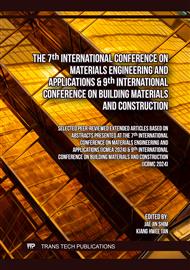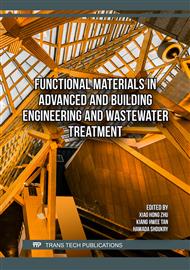[1]
M. Hadavi, H. Pasdarshahri, Impacts of urban buildings on microclimate and cooling systems efficiency: Coupled CFD and BES simulations, Sustain. Cities Soc. 67 (2021) 102740.
DOI: 10.1016/j.scs.2021.102740
Google Scholar
[2]
A. Katal, M. Mortezazadeh, L. (Leon) Wang, H. Yu, Urban building energy and microclimate modeling – From 3D city generation to dynamic simulations, Energy. 251 (2022) 123817.
DOI: 10.1016/j.energy.2022.123817
Google Scholar
[3]
R. Guo, Y. Gao, C. Zhuang, P. Heiselberg, R. Levinson, X. Zhao, D. Shi, Optimization of cool roof and night ventilation in office buildings: A case study in Xiamen, China, Renew. Energy. 147 (2020) 2279–2294.
DOI: 10.1016/j.renene.2019.10.032
Google Scholar
[4]
C. Spandagos, T.L. Ng, Equivalent full-load hours for assessing climate change impact on building cooling and heating energy consumption in large Asian cities, Appl. Energy. 189 (2017) 352–368.
DOI: 10.1016/j.apenergy.2016.12.039
Google Scholar
[5]
S. Malz, W. Krenkel, O. Steffens, Infrared reflective wall paint in buildings: Energy saving potentials and thermal comfort, Energy Build. 224 (2020) 110212.
DOI: 10.1016/j.enbuild.2020.110212
Google Scholar
[6]
H. Tang, S. Li, Y. Zhang, Y. Na, C. Sun, D. Zhao, J. Liu, Z. Zhou, Radiative cooling performance and life-cycle assessment of a scalable MgO paint for building applications, J. Clean. Prod. 380 (2022) 135035.
DOI: 10.1016/j.jclepro.2022.135035
Google Scholar
[7]
S. Wijesuriya, R.A. Kishore, M.V.A. Bianchi, C. Booten, Potential energy savings benefits and limitations of radiative cooling coatings for U.S. residential buildings, J. Clean. Prod. 379 (2022) 134763.
DOI: 10.1016/j.jclepro.2022.134763
Google Scholar
[8]
X. Yu, C. Chen, Coupling spectral-dependent radiative cooling with building energy simulation, Build. Environ. 197 (2021) 107841.
DOI: 10.1016/j.buildenv.2021.107841
Google Scholar
[9]
C. Yu, W. Pan, Inter-building effect on building energy consumption in high-density city contexts, Energy Build. 278 (2023) 112632.
DOI: 10.1016/j.enbuild.2022.112632
Google Scholar
[10]
K. Lin, L. Chao, T.C. Ho, C. Lin, S. Chen, Y. Du, B. Huang, C.Y. Tso, A flexible and scalable solution for daytime passive radiative cooling using polymer sheets, Energy Build. 252 (2021) 111400.
DOI: 10.1016/j.enbuild.2021.111400
Google Scholar
[11]
M. Panagiotidou, M.C. Brito, K. Hamza, J.J. Jasieniak, J. Zhou, Prospects of photovoltaic rooftops, walls and windows at a city to building scale, Sol. Energy. 230 (2021) 675–687.
DOI: 10.1016/j.solener.2021.10.060
Google Scholar



